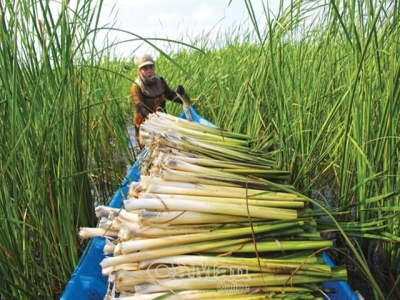Bulrush cultivation offers stable income for farmers

CÀ MAU – The cultivation of bồn bồn (Typha orientalis), also known as bulrush, has offered stable income for farmers in Khánh An Commune in Cà Mau Province’s U Minh District.
Harvested bulrush in Cà Mau Province’s U Minh District. – Photo baocamau
Bulrush is harvested for the inner portion of its lower stalk used as food. The wet plant is used in many dishes like fresh salads, pickles and hotpots.
The Cửu Long (Mekong) Delta province is entering the peak dry season and many farming areas are affected by drought, but bulrush farmers in the commune have high yields and stable incomes.
Lê Thị Chung has grown bulrush on a 3ha field in Khánh An’s Hamlet 1 for six years and harvests 3.5 – 4 tonnes of the inner portion of the lower stalks a month.
The inner portions are sold to traders at VNĐ22,000 – 25,000 (US$0.9 – 1.1) a kilogramme.
She earns a profit of more than VNĐ50 million ($2,100) a month.
“I have never suffered a loss from growing bulrush and have harvests to sell year round,” she said.
Traders from other localities visit the commune to buy bulrush since supply cannot meet demand, according to farmers.
The commune’s bulrush is sold in Cà Mau, other provinces and HCM City.
The commune has fresh water year round for the cultivation of bulrush, which grows in wet locations, including fields, ponds and lakes.
It is the peak dry season so farmers are pumping water into fields so that water levels are at least 50 centimeters deep for bulrush growth.
Bùi Văn Màu, who was the first farmer growing bulrush in Khánh An’s Hamlet 14, said: “With water pumping, farmers have bulrush harvests to sell in the dry season.”
Last year, Hamlet 14 established a co-operative group for growing bulrush. It helps its members access farming techniques and loans.
Tăng Văn Thắng, deputy head of the group, said its members earn a profit five times higher than from rice or banana.
The cultivation of bulrush also provides jobs for many labourers, he said.
Labourers who are hired to harvest bulrush are paid VNĐ200,000 ($8.4) a day and those who are hired to peel stalks get VNĐ80,000 – 120,000 ($3.4 - 5) a day.
Đặng Thành Công, deputy head of the Hamlet 14, said the hamlet has a submerged area, so bulrush cultivation in the dry season has a higher yield, quality and price than in the rainy season.
Farmers should grow small – leaf bulrush variety as it is resistant to alum-affected soil, and the inner portion of its lower stalk is sweeter and more delicious, he said.
The commune is located in the buffer zone of the U Minh Hạ National Park and most farmers live on rice and forests. However, the cultivation of rice does not provide high yield because of the alum-affected soil.
With stable income from bulrush cultivation, more farmers in the commune have switched to grow the plant. Bulrush cultivation has helped many households escape poverty.
Farmers also breed shrimp or fish in bulrush fields to earn additional income.
The commune has selected bulrush as its strong agricultural product for the “One Commune, One Product” programme launched nationwide in the 2018 – 20 period.
The commune will create conditions for farmers to develop bulrush cultivation sustainably to improve their income, according to local authorities.
Có thể bạn quan tâm
Phần mềm

Phối trộn thức ăn chăn nuôi

Pha dung dịch thủy canh

Định mức cho tôm ăn

Phối trộn phân bón NPK

Xác định tỷ lệ tôm sống

Chuyển đổi đơn vị phân bón

Xác định công suất sục khí

Chuyển đổi đơn vị tôm

Tính diện tích nhà kính

Tính thể tích ao hồ




 Potential of cooperatives in organic farming development untapped
Potential of cooperatives in organic farming development untapped  Farmers, businesses struggle as pepper, cashew prices drop
Farmers, businesses struggle as pepper, cashew prices drop